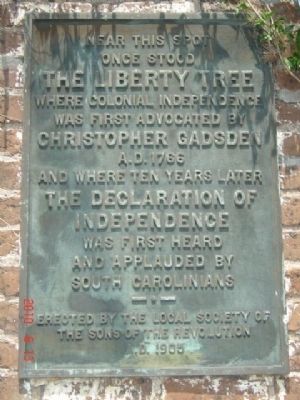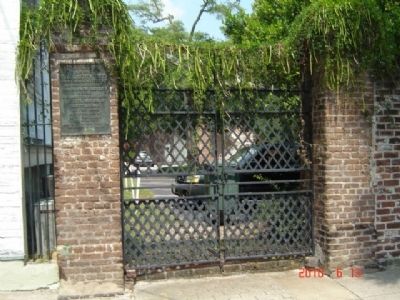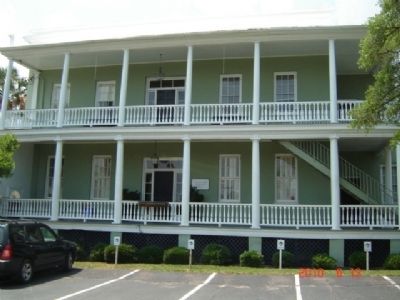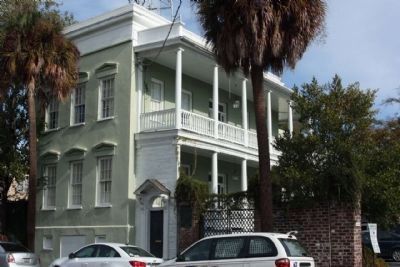Ansonborough in Charleston in Charleston County, South Carolina — The American South (South Atlantic)
The Liberty Tree
Erected 1905 by Local Society of the Sons of the Revolution.
Topics and series. This historical marker is listed in these topic lists: Colonial Era • Landmarks • Notable Events. In addition, it is included in the Historic Trees, and the Sons of the American Revolution (SAR) series lists. A significant historical year for this entry is 1766.
Location. 32° 47.352′ N, 79° 55.836′ W. Marker is in Charleston, South Carolina, in Charleston County. It is in Ansonborough. Marker is on Alexander Street, 0.1 miles north of Calhoun Street, on the right when traveling north. Touch for map. Marker is at or near this postal address: 80 Alexander Street, Charleston SC 29403, United States of America. Touch for directions.
Other nearby markers. At least 8 other markers are within walking distance of this marker. The Borough Houses (about 500 feet away, measured in a direct line); a different marker also named The Borough Houses (about 500 feet away); 28 Chapel Street (approx. 0.2 miles away); Blake-Grimké House (approx. 0.2 miles away); Emanuel AME Church (approx. 0.2 miles away); Emanuel A.M.E. Church (approx. 0.2 miles away); Emanuel African Methodist Episcopal Church (approx. 0.2 miles away); The Benjamin DuPré House (approx. 0.2 miles away). Touch for a list and map of all markers in Charleston.
Additional commentary.
1. Additional information about the “Sons of Liberty” and the takings place of that day.
Meeting of the revolutionary group the “Sons of Liberty” in the Fall 1766. (They were barred from meeting in public.) 1. Christopher Gadsden, Merchant. 2. Captain John William Johnson, Blacksmith. 3. Joseph Veree, Carpenter. 4. John Fullerton, Carpenter. 5. James Brown, Carpenter. 6. Nathaniel Libby, Ship Carpenter. 7. George Flagg, Painter & Glazier. 8. Thomas Coleman, Upholsterer. 9. John Hall, Coachmaker. 10. William Field, Carver. 11. Robert Jones, Sadler. 12. John Loughton, Coachmaker. 13. W. Rodgers, Wheelwright. 14. John Calvert, Clerk. 15. H. Y. Bookless, Wheelwright. 16. J. Barlow, Sadler. 17. Tunis Teabout, Blacksmith. 18. Peter Munclean, Clerk. 19. William Trusser, Butcher. 20. Robert Howard, Carpenter. 21. Alex. Alexander, Schoolmaster. 22. Edward Weyman, Clerk of St. Philip’s Church & glass grinder. 23. Thomas Swarle, Painter. 24. William Laughton, Tailor. 25. Daniel Cannon, Carpenter. 26. Benjamin Hawes, Painter. On this occasion the above persons invited Mr. Gadsden to join them and to meet at a large oak tree in Mr Mazyck’s cow pasture. They talked over the mischiefs which the Stamp Act would have induced, and congratulated each other on its repeal. On this occasion Mr. Gadsden delivered to them an address, stating their rights and encouraging them to defend them against all foreign taxation. Upon which joining hands around the tree, they associated themselves as defenders and supporters of American Liberty and from that time on the oak was called The Liberty Tree. It was also where our copy of the Declaration of Independence was publicly read. The tree was such an icon of American spirit that one of the first things the British siege troops attended to after the fall of our city was to cut down the tree and burn the stump. When we won the American Revolution, though, patriots dug up the root of the tree and made cane heads with it, one of which was given to Thomas Jefferson.
Note To Editor only visible by Contributor and editor
— Submitted May 23, 2019, by Heather Gant Evans of Gainesville, Georgia.
Credits. This page was last revised on February 16, 2023. It was originally submitted on June 14, 2010, by Michael Sean Nix of Spartanburg, South Carolina. This page has been viewed 3,352 times since then and 196 times this year. Photos: 1, 2, 3. submitted on June 14, 2010, by Michael Sean Nix of Spartanburg, South Carolina. 4. submitted on January 24, 2012, by Mike Stroud of Bluffton, South Carolina. • Bill Pfingsten was the editor who published this page.



